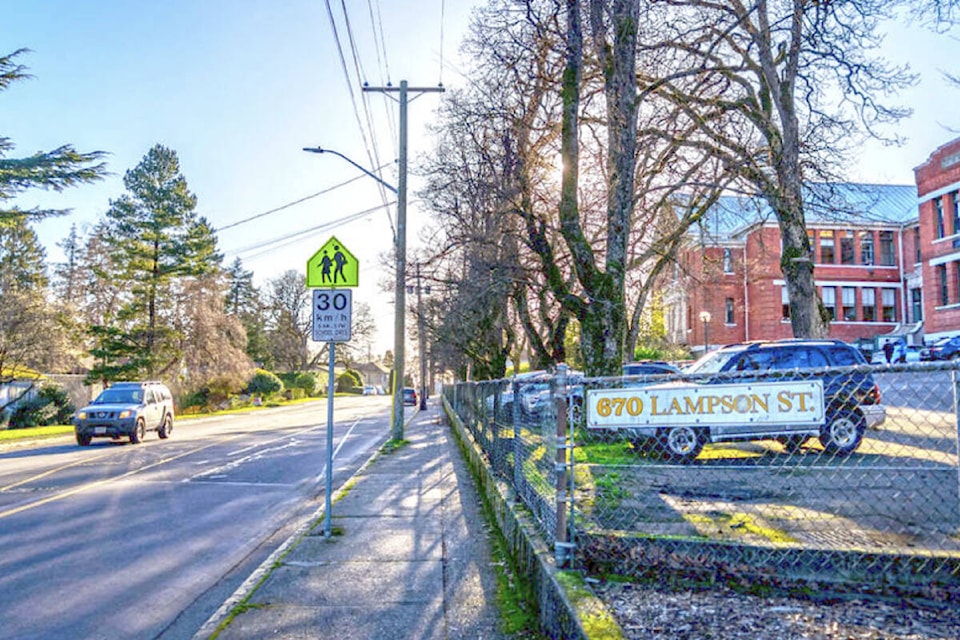A proposal for a new active transportation lane for bikes, scooters and more in Esquimalt is racing to the next phase, with the goal of starting construction in May.
After finishing up a public engagement phase during December, Joel Clary, director of Engineering and Public Works for Esquimalt, met with council to discuss next steps.
Coun. Tim Morrison expressed concern about the construction of the lane impeding traffic at the intersection of Craigflower and Admiral, worrying construction of a median would hinder cars from bypassing the bus that will sometimes pause at the bus stop right after the intersection if it is ahead of schedule.
“My understanding is there would be space for vehicles to get around but that is something that we can confirm when we go into the detailed design,” said Clary. “Given the conditions of the bus stops, there is really limited opportunities there to make changes, but we’ve had those conversations with them (BC Transit) and they are well aware of the changes we are making.”
Mayor Barbara Desjardins reiterated the traffic flow around the bus stop was one aspect of the project council wants the department to focus on monitoring.
Balancing the need for an active transportation lane as well as prioritizing the flow of traffic, including emergency vehicles and reducing driver frustration, remain at the top of council’s concerns.
Clary said emergency vehicles will also have plenty of space to move through, as the traffic-slowing curb included in the plan will only take up around a car length of space. With such a short space blocked, Clary said cars will have ample room to move over making way for emergency vehicles.
On Lampson, which does not have a centre lane, Clary said average-sized vehicles can pull off to the side, but larger vehicles such as trucks may need to clear the lane using cross streets.
The Engineering and Public Works Department will be reviewing the detailed design with Esquimalt Fire, as well as with Victoria Police. Clary said it is the intent of the department to also consult BC Ambulance.
Questions from the public raised concerns that the installment of a bike lane on Lampson, which would result in a lost vehicle lane, will cause a significant amount of traffic backup toward the bridge during rush hour, which Coun. Ken Armour noted can already be challenging to navigate.
Clary agreed that losing a lane would increase the amount of traffic that could build up, but offered a solution that would see a change in signal timing, allowing traffic to flow more easily.
In the current signal configuration, the north and south lanes alternate going through the lights, but it could be configured to allow both lanes to progress through the intersection at the same time, while maintaining turning lanes.
“What that could look like at an intersection like Tillicum and Craigflower … We would be looking to have those movements go at the same time so the left turns would go at the same time, followed by a longer portion of through (traffic), which would help clear the backlog that is forming,” Clary said.
Going forward, Armour and Coun. Andrea Boardman reiterated their interest in continuous monitoring of the intersections to ensure there will not be any surprises or issues.
“I do think it is important that we evaluate the work that we do so that we can ensure that there are not any unanticipated consequences and also that we are successful in what we plan to do,” Boardman said.
Finalizing the design of the project will continue through February, with construction anticipated to begin in May.
One main goal of the construction would be to have it finished prior to the school year, to mitigate construction traffic as children are heading back to class.
A focus on providing new signage to indicate changes in the traffic pattern is also high on the list of priorities to mitigate frustration in adjusting to the new road flow.
The council expressed support for the implementation of the active transportation lanes, while acknowledging there will be approximately six to eight weeks of citizen engagement when the project is complete, as residents both drivers and pedestrians become accustomed to the changes.
“Communication is going to be extremely important, monitoring is going important and these are things we are hopeful will be followed up with,” Desjardins said.
READ ALSO: Esquimalt adding new protected bike and pedestrian lanes in 2023
Do you have a story tip? Email: vnc.editorial@blackpress.ca.
Follow us on Twitter and Instagram, and like us on Facebook.
